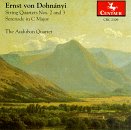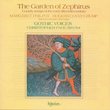| All Artists: Ernst von Dohnanyi Title: Dohnányi: String Quartets Nos. 2 and 3; Serenade in C Major Members Wishing: 1 Total Copies: 0 Label: Centaur Release Date: 10/1/1996 Album Type: Import Genre: Classical Style: Chamber Music Number of Discs: 1 SwapaCD Credits: 1 UPC: 789368443628 |
Search - Ernst von Dohnanyi :: Dohnányi: String Quartets Nos. 2 and 3; Serenade in C Major
 | Ernst von Dohnanyi Dohnányi: String Quartets Nos. 2 and 3; Serenade in C Major Genre: Classical
|
Larger Image |
CD DetailsSimilar CDs
|
CD ReviewsStrad Magazine and Fanfare Magzine reviews 01/26/1999 (5 out of 5 stars) "The Strad / September, 1997We have yet to see if the dust will re-settle on such newly fashionable composers as Korngold and Goldschmidt. But the case of Ernst von Dohnányi (1877-1960), nobody seems to have a real attempt to blow away the dust in the first place, which seems rather unfair. Even Edward Eanes's accompanying note speaks much of Brahms and thus, by implication, consigns the Hungarian to arch-conservative ranks. In fact, Dohnányi's music reminds one rather more of Strauss, being often highly chromatic; moreover, the sudden switches of mood and tempo are quite individual. This latter characteristic is brilliantly captured by the Audubon Quartet, which also displays pellucid elegance and a loveliness of line that suits material of competenceand integrity rather than of notable depth. The minor novelties in the Presto of Quartet no.2 - the dry, off-the-string cello stage setting, the gently caressing central chorale with liquid pizzicatto underpinning - are dispatched with sophistication and deftness, and the American team is equally at home in the less tonal world of the Third Quartet. Sweetness and clarity mark the Allegro agitato, in which there is also a sensitive tailoring of cadance and some (not too explosive) drama at the start of the development as the prevalent descending fifth disrupts and distorts. The melodically rather undistinguished finale is performed with immense élan; I commend to collectors the sly portamentos, the bunched clusters with telling pauses and superlative balancing. In revoking 18th-century procedures for the purposes of his 1902 Serenade for string trio, Dohnányi remained true to his style, and the group (minus Audubon leader David Ehrlich) which tackles, it maintains, an exceptional level of sympathetic musicianship. A punctiliously realised fugal Scherzo lingers in the memory, as does the air of quiet mystery brought to bear at the beginning of the Tema con Variazioni. Jeffery Joseph Fanfare Magazine / March/April 1997Are we on the brink of a Dohnányi renascence? Chandos's ear-opening premiere recording of his lavish Second Symphony (see Fanfare 20:2) certainly proposed that it was time to review our popular conceptions of his compositional profile; and that proposal is firmly seconded by the flood of Dohnányi discs that arrived this month. True, neither of these relatively unfamiliar violin concertos (only the First has, I believe, been recorded before; see 12:6) rivals the symphony for resourcefulness. Still, they're both inventive enough to cast a shadow over the traditional picture of Dohnányi as a mere Brahms sequel.They're also sufficiently substantial to serve an an antidote to John Wiser's repeated assertion that Dohnányi was a lightweight prankster -- a composer laudable for his "sly humor" (16:1) or, more pointedly, one whose music is saved from "mediocrity" through "affectionate satire" (17:5). Indeed, while both of these lusciously melodic and intricately textured concertos have their lighter, dance-tinged moments (the First's tipsy third movement, the second and fourth movements of the Second), their overall ambience is grave, even somber (in fact, the Second dispenses with orchestral violins, filtering out brightness considerably). Both begin with dark, questing (but also questioning) themes that reveal a strong family resemblance to the principal theme of the first movement of the Second Piano Concerto; and both have a haunting capacity to throw the listener off balance, not delectably so much as disturbingly. The anguish of the First's first movement frequently melts into an unexpectedly honeyed lyricism that provides respite, but never real relief; the third movement of the Second, where Dohnányi reveals a kinship in spirit (if not in precise demeanor) to the Strauss of the Four Last Songs, keeps thwarting its own harmonic progress with odd turns. Indeed, even though Dohnányi generally hews to traditional structures, the Second plays some formal games as well, starting in medias res and refusing to follow through on the virtuoso display near the end of the finale. Both performances have committed advocates in the solo parts -- although the First has more polished orchestral support and a more natural recording acoustic. In sum, lovers of the post-Romantic should find these discs to be attractive additions to their shelves.They would be more attractive still with better couplings. The cpo First is accompanied by the lushly orchestrated, richly textured, but deservedly obscure 1953 American Rhapsody, a folk-inspired extravaganza that could only have been written by a recent arrival who knew the tunes but not their cultural associations. Who else could launch a piece, apparently in all seriousness, with the opening three phrases of "On Top of Old Smokey," each portentously announced by the brass, with ominous harmonies and an urgent, scurrying string background? True, much of the piece handles its materials less incongruously; but then again, some passages -- especially the arrival of "Sweet Betsy From Pike" toward the end -- are even more maladroit.As for the Bartók half of the Koch International issue: Robert Maxham praised the ferocity of Kaplan's performances of some Bartók chamber music in 18:2. But the expertly polished playing here (note his gracious handling of the "molto tranquillo" at m. 320 in the Finale) sounds mellower than anything he described. Indeed, on his very first entrance, Kaplan puts on the brakes, even though the orchestra is already below tempo. It's a sound enough approach, but it's marred by the orchestral contribution, which is noticeably less accomplished than that in the Dohnányi: rapid gestures are often approximated, sudden mood shifts (for instance, the dynamic drop in mm. 259-60 of the Finale) are dampened, and big gestures (e.g., the orchestral crescendo at the end of the first movement) are weak-willed. The lack of orchestral bite is especially frustrating because this recording revives Bartók's first version of the coda to the Finale, a version that dispenses with the soloist in favor of improvident fireworks -- including barrages of brass glissandos -- for the orchestra. The premature exit of the protagonist is awkward in any case; but it sounds especially klutzy in the slightly tame reading we get here. (Both versions of the Finale, by the way, are offered on the Zukerman/Slatkin account, reviewed by James H. North in 15:3).Dohnányi's chamber music is more familiar fare than his concertos -- but the three works on the Centaur collection turn out to be more potent than usual in these sensational new readings. The Audubon Quartet is best known to record collectors for its performances of contemporary music, so it's perhaps no surprise that it takes a modernistic approach to these scores, playing up their harmonic punch, their formal discontinuities, and their rhythmic momentum (listen, for instance, to the drive in the passage toward the end of the third movement of the Second, which looks ahead to the culmination of Rachmaninov's Symphonic Dances). Thus, the Second Quartet is often called Brahmsian -- but in this high-energy and texturally active performance, it turns out to be Brahmsian in the way early Schoenberg and Webern are. The Audubon similarly makes the most of the hyperkinetic, even obsessive passages of the Third, which serve as a foil to the pull of its intense, nearly expressionistic harmonies. Even the Serenade, usually celebrated for its good-natured charm, has an angry edge (try the manic counterpoint in the outer sections of the third movement). It's not that the Audubon Quartet is insensitive to the music's less outgoing moments (for instance, the transparent chorale at the center of the middle movement of the Second) -- but it refuses to let those passages neutralize the music's underlying nervousness. Fine sound, too. One can only hope that Centaur has further plans for this sadly underrecorded ensemble.Peter J. Rabinowitz"
|

 Track Listings (11) - Disc #1
Track Listings (11) - Disc #1


